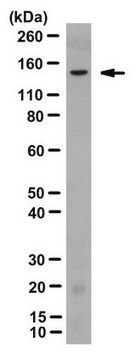General description
We are committed to bringing you greener alternative products, which adhere to one or more of The 12 Principles of Green Chemistry.This antibody is Preservative-free, produced without the harm or sacrifice of animals and exceptionally stable to allow for ambient shipping and storage if needed and thus aligns with "Waste Prevention", "Designing Safer Chemicals" and "Design for Energy Efficiency".
Click here for more information.
ZooMAb® antibodies represent an entirely new generation of recombinant monoclonal antibodies.Each ZooMAb® antibody is manufactured using our proprietary recombinant expression system, purified to homogeneity, and precisely dispensed to produce robust and highly reproducible lot-to-lot consistency. Only top-performing clones are released for use by researchers. Each antibody is validated for high specificity and affinity across multiple applications, including its most commonly used application. ZooMAb® antibodies are reliably available and ready to ship when you need them.
Specificity
Clone Sulfo-1C-A2 is a ZooMAb® Mouse recombinant monoclonal antibody that specifically detects sulfated tyrosine residues on various proteins. It does not recognize phosphotyrosine or unmodified tyrosines.
Immunogen
Developed using a phage display library as described in Kehoe, JW., et al. (2006). Mol. Cell. Proteomics. 5(12); 2350-2563. The selection antigens were KAKISDP-DY(SO3)MTGYMDAC and KDKKYATEY(SO3)-EYLDYDFC.
Application
Quality Control Testing
Evaluated by Western Blotting with Bovine Fibrinogen.
Western Blotting Analysis (WB): A 1:1,000 dilution of this antibody detected Sulfotyrosine in Bovine Fibrinogen, but not in Fibrinogen treated with Sodium Acetate and Abalone Sulfatase.
Tested applications
Immunohistochemistry (Paraffin) Analysis: A 1:100 dilution from a representative lot detected Sulfotyrosine in human kidney tissue sections.
Immunocytochemistry Analysis: A 1:1,000 dilution from a representative lo detected Sulfotyrosine in Human umbilical vein endothelial cells.
Note: Actual optimal working dilutions must be determined by end user as specimens, and experimental conditions may vary with the end user
Target description
Protein tyrosine O-sulfation is a post-translational modification mediated by two Golgi tyrosylprotein sulfotransferases (TPST1 and TPST2) that catalyze the transfer of sulfate to tyrosine residues in secreted and transmembrane proteins. These enzymes catalyze the transfer of sulfate from 3 -phosphoadenosine 5 -phosphosulfate to tyrosine residues in proteins. TPST 1 and 2 are type II transmembrane proteins that reside in the trans-Golgi network and have luminally oriented catalytic domain. Hence, tyrosine sulfation occurs only on soluble and transmembrane proteins that transit the Golgi en route to either secretion or incorporation into the plasma membrane. Tyrosine sulfation occurs in all multicellular organisms and up to 1% of the tyrosine residues in the total protein content of a cell can be sulfated. Tyrosine sulfation is shown to be essential for several biological processes, such as optimal proteolytic processing of progastrin, proteolytic activation of coagulation factors V and VIII by thrombin, proteolysis of the complement C4a-chain by C1s. Sulfotyrosine is also reported to be involved in the entry of several parasites and viruses into cells. Tyrosine sulfation of the HIV-1 co-receptor CCR5 is required for viral entry into host cells. This ZooMAbZooMAb® recombinant monoclonal antibody, generated by our propriety technology, offers significantly enhanced specificity, affinity, reproducibility, and stability over conventional monoclonals. (Ref.: Huang, C., et al. (2007). Science. 317(5846); 1930-1934; Kehoe, JW., et al. (2006). Mol. Cell. Proteomics. 5(12); 2350-2563; Hoffhines, AJ., et al. (2006). J. Biol. Chem. 281(49); 37877-37887).
Physical form
Purified recombinant mouse monoclonal antibody IgG, lyophilized in PBS with 5% Trehalose, normal appearance a coarse or translucent resin. The PBS/trehalose components in the ZooMAb formulation can have the appearance of a semi-solid (bead like gel) after lyophilization. This is a normal phenomenon. Please follow the recommended reconstitution procedure in the data sheet to dissolve the semi-solid, bead-like, gel-appearing material. The resulting antibody solution is completely stable and functional as proven by full functional testing. Contains no biocide or preservatives, such as azide, or any animal by-products. Larger pack sizes provided as multiples of 25 μL.
Reconstitution
300 μg/mL after reconstitution at 25 μL per vial. Please refer to guidance on suggested starting dilutions and/or titers per application and sample type.
Storage and Stability
Recommend storage of lyophilized product at 2-8°C; Before reconstitution, micro-centrifuge vials briefly to spin down material to bottom of the vial; Reconstitute each vial by adding 25 μL of filtered lab grade water or PBS; Reconstituted antibodies can be stored at 2-8°C, or -20°C for long term storage. Avoid repeated freeze-thaws.
Legal Information
ZooMAb is a registered trademark of Merck KGaA, Darmstadt, Germany
Disclaimer
Unless otherwise stated in our catalog or other company documentation accompanying the product(s), our products are intended for research use only and are not to be used for any other purpose, which includes but is not limited to, unauthorized commercial uses, in vitro diagnostic uses, ex vivo or in vivo therapeutic uses or any type of consumption or application to humans or animals.

